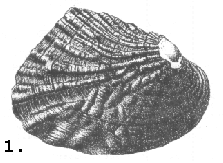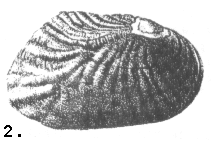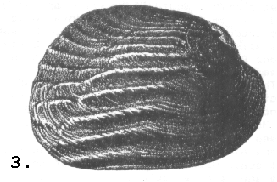| Champion Clams Of Florida | ||||||||||||||||||||||||||||||
| By Harry G. Lee | ||||||||||||||||||||||||||||||
| Our
state has an uncontested champion gastropod in its State Shell,
the Horse Conch, which approaches two feet in length. One
wonders, on the other hand, how Florida conchologists would
respond to the hypothetical query: "What is the state's
largest clam?" Could it be the Campeche Quahog, paired
shells of which have exceeded six lbs. in weight; the bantam
weight foot-long Pen Shells (Atrina
spp.); or the Geoduck (Panopea bitruncata),
the soft parts of which dwarf the five to eight inch shells and
can span a three foot burrow? The list shouldn't stop there!
Consider Boykin's Washboard, our longest and most ponderous
pearly freshwater mussel; it deserves at least contender status. The recent unseasonably low stage of most Florida rivers has lured mussel collectors, two legged ones especially into the field - the streams of the Florida Panhandle being a special attraction. On June 14 and 15, 1986 such an expedition by Henry McCullagh and the writer discovered mussel beds which for years had been in too deep or too treacherous a situation (or both) for collecting at several stations along the Ochlockonee, Appalachicola, and Choctawhatchee Rivers. This report deals with giant specimens of three naiad species collected among dozens of mature shells under such propitious conditions a short distance below the Jim Woodruff Dam, near Chattahoochee, Gadsden Co., Florida. This dam is the point of origin of the Appalachicola River, at the confluence of the Flint and Chattahoochee on the Florida-Georgia border. A review of the naiad literature indicates that these shells are big enough to demand the attention of any serious conchologist. Heretofore the largest specifically - recorded sizes of most Florida naiads were those of Clench and Turner (l956) although Bill Heard (1979) suggested, through his scaled illustrations, somewhat greater dimensions for a few species. The following shells are in the writer's collection:
The shells of Boykins Washboard (No. 1) rival those of its giant marine cousins when one considers both length and weight of the empty shells - heavier than the Pen Shells and Geoduck; longer than the Quahog and Geoduck. In one less hypothetical comparison this mussel (and many others; see illustrations) surpasses the saltwater competition - sheer beauty! 1. Clench, W. J. and R. D. Turner (1956) Freshwater mollusks of Alabama, Georgia, and Florida from the Escambia to the Suwannee River Bull. Florida State Museum, Biol. Sci. 1:97-239. 2. Heard, W. H. (1979) Identification Manual of the Freshwater Clams of Florida D.E.R., Tallahassee. 83 pp incl. 88 fig. 3. Illustrations taken from Lea, I. (1834-1874) Observations on the Genus Unio.... Privately published, Philadelphia. |
||||||||||||||||||||||||||||||


